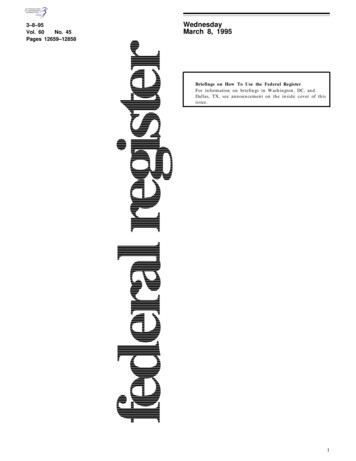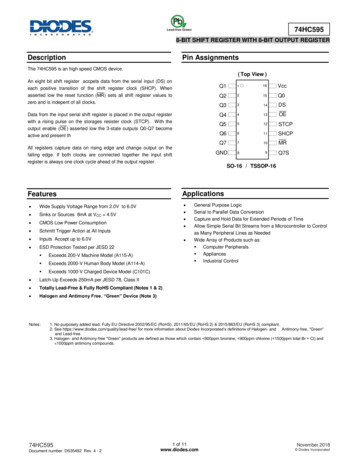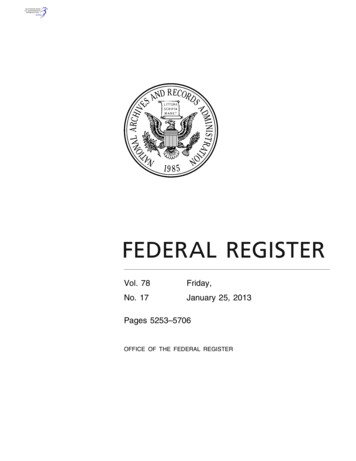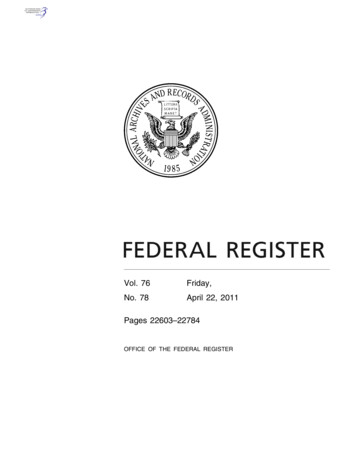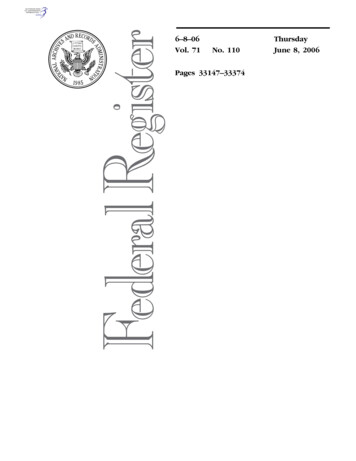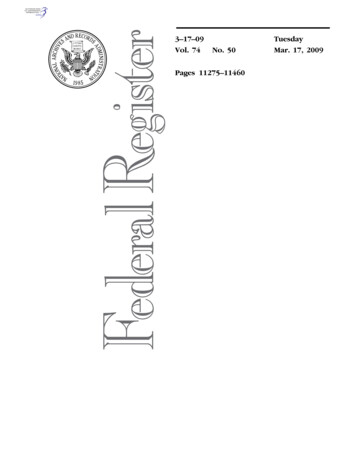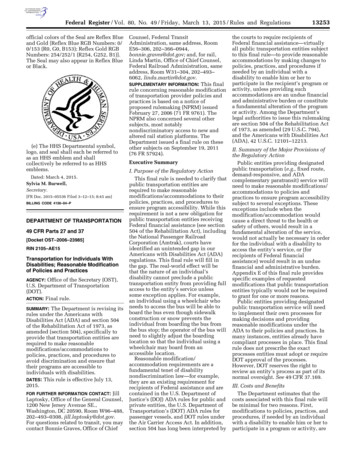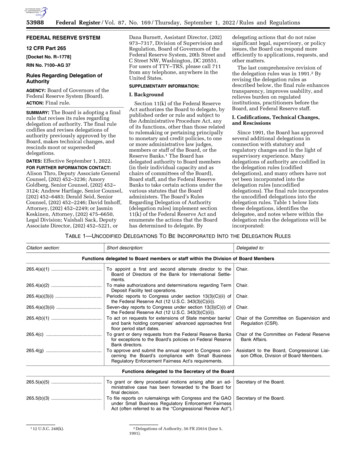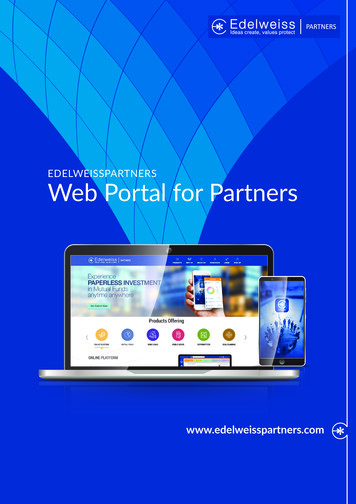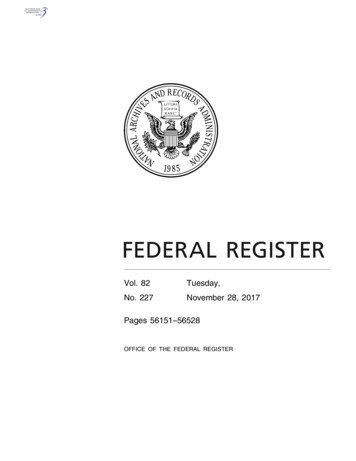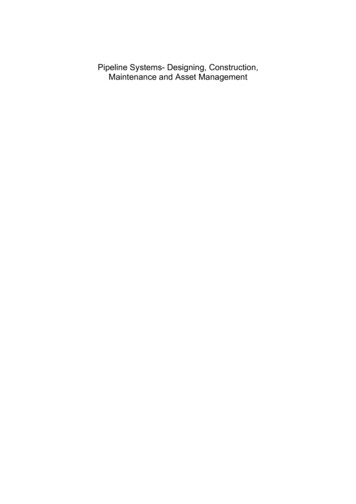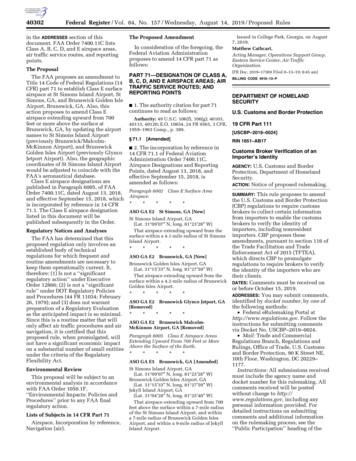
Transcription
40302Federal Register / Vol. 84, No. 157 / Wednesday, August 14, 2019 / Proposed Rulesin the ADDRESSES section of thisdocument. FAA Order 7400.11C listsClass A, B, C, D, and E airspace areas,air traffic service routes, and reportingpoints.The ProposalThe FAA proposes an amendment toTitle 14 Code of Federal Regulations (14CFR) part 71 to establish Class E surfaceairspace at St Simons Island Airport, StSimons, GA, and Brunswick Golden IsleAirport, Brunswick, GA. Also, thisaction proposes to amend Class Eairspace extending upward from 700feet or more above the surface atBrunswick, GA, by updating the airportnames to St Simons Island Airport(previously Brunswick/MalcolmMcKinnon Airport), and BrunswickGolden Isles Airport (previously GlyncoJetport Airport). Also, the geographiccoordinates of St Simons Island Airportwould be adjusted to coincide with theFAA’s aeronautical database.Class E airspace designations arepublished in Paragraph 6005, of FAAOrder 7400.11C, dated August 13, 2018,and effective September 15, 2018, whichis incorporated by reference in 14 CFR71.1. The Class E airspace designationlisted in this document will bepublished subsequently in the Order.khammond on DSKBBV9HB2PROD with PROPOSALSRegulatory Notices and AnalysesThe FAA has determined that thisproposed regulation only involves anestablished body of technicalregulations for which frequent androutine amendments are necessary tokeep them operationally current. It,therefore: (1) Is not a ‘‘significantregulatory action’’ under ExecutiveOrder 12866; (2) is not a ‘‘significantrule’’ under DOT Regulatory Policiesand Procedures (44 FR 11034; February26, 1979); and (3) does not warrantpreparation of a Regulatory Evaluationas the anticipated impact is so minimal.Since this is a routine matter that willonly affect air traffic procedures and airnavigation, it is certified that thisproposed rule, when promulgated, willnot have a significant economic impacton a substantial number of small entitiesunder the criteria of the RegulatoryFlexibility Act.Environmental ReviewThis proposal will be subject to anenvironmental analysis in accordancewith FAA Order 1050.1F,‘‘Environmental Impacts: Policies andProcedures’’ prior to any FAA finalregulatory action.Lists of Subjects in 14 CFR Part 71Airspace, Incorporation by reference,Navigation (air).VerDate Sep 11 201416:38 Aug 13, 2019Jkt 247001The Proposed AmendmentIn consideration of the foregoing, theFederal Aviation Administrationproposes to amend 14 CFR part 71 asfollows:PART 71—DESIGNATION OF CLASS A,B, C, D, AND E AIRSPACE AREAS; AIRTRAFFIC SERVICE ROUTES; ANDREPORTING POINTS1. The authority citation for part 71continues to read as follows: Issued in College Park, Georgia, on August7, 2019.Matthew Cathcart,Acting Manager, Operations Support Group,Eastern Service Center, Air TrafficOrganization.[FR Doc. 2019–17369 Filed 8–13–19; 8:45 am]BILLING CODE 4910–13–PDEPARTMENT OF HOMELANDSECURITYU.S. Customs and Border ProtectionAuthority: 49 U.S.C. 106(f), 106(g); 40103,40113, 40120; E.O. 10854, 24 FR 9565, 3 CFR,1959–1963 Comp., p. 389.19 CFR Part 111§ 71.1RIN 1651–AB17[Amended]2. The incorporation by reference in14 CFR 71.1 of Federal AviationAdministration Order 7400.11C,Airspace Designations and ReportingPoints, dated August 13, 2018, andeffective September 15, 2018, isamended as follows: Paragraph 6002Airspace.Class E Surface Area****ASO GA E2*St Simons, GA [New]St Simons Island Airport, GA(Lat. 31 09′07″ N, long. 81 23′28″ W)That airspace extending upward from thesurface within a 4.1-mile radius of St SimonsIsland Airport.***ASO GA E2**Brunswick, GA [New]Brunswick Golden Isles Airport, GA(Lat. 31 15′33″ N, long. 81 27′59″ W)That airspace extending upward from thesurface within a 4.2-mile radius of BrunswickGolden Isles Airport.***ASO GA E2[Removed]****Brunswick Glynco Jetport, GA***ASO GA E2 Brunswick MalcolmMcKinnon Airport, GA [Removed]Paragraph 6005 Class E Airspace AreasExtending Upward From 700 Feet or MoreAbove the Surface of the Earth.***ASO GA E5**Brunswick, GA [Amended]St Simons Island Airport, GA(Lat. 31 09′07″ N, long. 81 23′28″ W)Brunswick Golden Isles Airport, GA(Lat. 31 15′33″ N, long. 81 27′59″ W)Jekyll Island Airport, GA(Lat. 31 04′28″ N, long. 81 25′40″ W)That airspace extending upward from 700feet above the surface within a 7-mile radiusof the St Simons Island Airport, and withina 7-mile radius of Brunswick Golden IslesAirport, and within a 9-mile radius of JekyllIsland Airport.PO 00000Frm 00006Fmt 4702Sfmt 4702[USCBP–2019–0024]Customs Broker Verification of anImporter’s IdentityU.S. Customs and BorderProtection, Department of HomelandSecurity.ACTION: Notice of proposed rulemaking.AGENCY:This rule proposes to amendthe U.S. Customs and Border Protection(CBP) regulations to require customsbrokers to collect certain informationfrom importers to enable the customsbrokers to verify the identity ofimporters, including nonresidentimporters. CBP proposes theseamendments, pursuant to section 116 ofthe Trade Facilitation and TradeEnforcement Act of 2015 (TFTEA),which directs CBP to promulgateregulations to require brokers to verifythe identity of the importers who aretheir clients.DATES: Comments must be received onor before October 15, 2019.ADDRESSES: You may submit comments,identified by docket number, by one ofthe following methods: Federal eRulemaking Portal athttp://www.regulations.gov. Follow theinstructions for submitting commentsvia Docket No. USCBP–2019–0024. Mail: Trade and CommercialRegulations Branch, Regulations andRulings, Office of Trade, U.S. Customsand Border Protection, 90 K Street NE,10th Floor, Washington, DC 20229–1177.Instructions: All submissions receivedmust include the agency name anddocket number for this rulemaking. Allcomments received will be postedwithout change to http://www.regulations.gov, including anypersonal information provided. Fordetailed instructions on submittingcomments and additional informationon the rulemaking process, see the‘‘Public Participation’’ heading of theSUMMARY:E:\FR\FM\14AUP1.SGM14AUP1
Federal Register / Vol. 84, No. 157 / Wednesday, August 14, 2019 / Proposed RulesSUPPLEMENTARY INFORMATION section ofthis document.Docket: For access to the docket toread background documents orcomments received, go to http://www.regulations.gov. Submittedcomments may be inspected duringregular business days between the hoursof 9 a.m. and 4:30 p.m. at the Trade andCommercial Regulations Branch,Regulations and Rulings, Office ofTrade, U.S. Customs and BorderProtection, 90 K Street NE, 10th Floor,Washington, DC 20229–1177.Arrangements to inspect submittedcomments should be made in advanceby calling Mr. Joseph Clark at (202) 325–0118.FOR FURTHER INFORMATION CONTACT:Randy Mitchell, Director, CommercialOperations Revenue Entry Division,Office of Trade, U.S. Customs andBorder Protection, MENTARY INFORMATION:I. Public ParticipationInterested persons are invited toparticipate in this rulemaking bysubmitting written data, views, orarguments on all aspects of thisproposed rule. U.S. Customs and BorderProtection (CBP) also invites commentsthat relate to the economic,environmental, or federalism effects thatmight result from this regulatorychange. Comments that will provide themost assistance to CBP will reference aspecific portion of the rule, explain thereason for any recommended change,and include data, information orauthority that support suchrecommended change. See ADDRESSESabove for information on how to submitcomments.khammond on DSKBBV9HB2PROD with PROPOSALSII. BackgroundSection 641 of the Tariff Act of 1930,as amended (19 U.S.C. 1641), providesthat individuals and business entitiesmust hold a valid customs broker’slicense and permit in order to transactcustoms business on behalf of others.The statute also sets forth standards forthe issuance of broker’s licenses andpermits, provides for disciplinary actionagainst brokers in the form ofsuspension or revocation of suchlicenses and permits or assessment ofmonetary penalties, and provides for theassessment of monetary penaltiesagainst other persons for conductingcustoms business without the requiredbroker’s license. Section 641 authorizesthe Secretary of the Treasury toprescribe rules and regulations relatingto the customs business of brokers asmay be necessary to protect importersVerDate Sep 11 201416:38 Aug 13, 2019Jkt 247001and the revenue of the United Statesand to carry out the provisions ofsection 641.1The regulations issued under theauthority of section 641 are set forth inpart 111 of title 19 of the Code ofFederal Regulations (CFR) (19 CFR part111). Customs brokers serve manyfunctions when acting on behalf of theirclients, which include resident andnonresident importers. Customs brokersfile information about their clients’merchandise and transactions with CBP.Customs brokers also track shipments,pay duties and fees to CBP, and keepcurrent documents and records aboutthe business they transact on behalf oftheir clients, all to help their clientscomply with Federal import and exportlaws. See 19 CFR part 111 subpart C.However, before a customs brokermay transact customs business on behalfof a client, the broker must obtain avalid power of attorney (POA). 19 CFR141.46. A POA authorizes the customsbroker to become that client’s agent andto prepare and file the necessarycustoms documents on their behalf.A. Current POA RegulationsIn the customs broker context, a validPOA is the written appointment of thebroker as the true and lawful agent ofthe principal (i.e., client) allowed totransact customs business on behalf ofthe principal. The regulations governingPOAs are set forth in 19 CFR part 141subpart C.A POA may be executed for aspecified part of the principal’s business(limited power of attorney) or all of theprincipal’s customs business (generalpower of attorney). See 19 CFR141.31(a). Pursuant to 19 CFR 141.32,POAs can be executed through variousmeans. CBP Form 5291 may be used toestablish a power of attorney. If CBPForm 5291 is not used, a limited POAmust be executed in the same mannerand as explicit in its terms as CBP Form5291. 19 CFR 141.32. A general POAwith unlimited authority may be1 The Homeland Security Act of 2002 generallytransferred the functions of the U.S. CustomsService from the Treasury Department to theSecretary of the Department of Homeland Security(DHS). See Pub. L. 107–296, 116 Stat. 2142. The Actprovides that the Secretary of the Treasury retainscustoms revenue functions unless delegated to theSecretary of DHS. The regulation of customs brokersis encompassed within the customs revenuefunctions set forth in section 412 of the HomelandSecurity Act. On May 15, 2003, the Secretary of theTreasury delegated authority related to the customsrevenue functions to the Secretary of DHS subjectto certain exceptions. See Treasury Order No. 100–16 (Appendix to 19 CFR part 0). Since the authorityto prescribe the rules and regulations related tocustoms brokers is not listed as one of theexceptions, this authority now resides with theSecretary of DHS.PO 00000Frm 00007Fmt 4702Sfmt 470240303executed in any format. See 19 CFR141.32.A POA issued by a partnership islimited to a period not to exceed twoyears from the date of execution. 19 CFR141.34. All other POAs may be grantedfor an unlimited period of time. 19 CFR141.34.A valid POA requires the principal toprovide only limited information. Theprincipal is required to provide:(1) A statement from the principalauthorizing the customs broker to act asthe principal’s agent and for thecustoms broker to file entry/entrysummary in the principal’s name for ashipment;(2) The name of the individual or theauthorized representative of the soleproprietorship, partnership, orcorporation executing the POA; and(3) The name and address of theindividual or business on whose behalfthe POA is being executed.See 19 CFR 141.32; 141.36–.39.B. Customs Brokers’ Current Practice forVerifying Importer’s IdentityWhile only a limited amount ofinformation is required for a valid POA,the majority of customs brokerscurrently require additional informationwhen a POA is obtained from animporter, which is used by the broker toverify the importer’s existence andidentity. Brokers require this additionalinformation and have initiatedprocesses and procedures to validate animporter’s identity in order to protectthe broker’s business interests, reduceidentity theft, and help to prevent theuse of shell 2 or shelf 3 companies tofurther a business fraud scheme.Additional information that a brokermight request includes, but is notlimited to, the registration of theimporter’s business with a stategovernment and the Articles ofIncorporation under which thatbusiness is formed.CBP provides non-binding guidanceon how brokers can validate importerswhen they obtain a POA. For example,CBP recommends that a broker should,whenever possible, do the following: 42 A shell company is a company without activebusiness operations or significant assets, which maybe used illegitimately to disguise businessownership or operations.3 A shelf company is a company which wascreated and maintained by legal means, but is leftdormant for a period of time before its sale to abuyer, which may serve to conceal the buyer’sidentity and history of business transactions so asnot to appear as a new business entity.4 See U.S. Customs and Border Protection,‘‘Validating the Power of Attorney’’ forcomprehensive list of recommendations. Lastpublished May 25, 2018. Available at https://E:\FR\FM\14AUP1.SGMContinued14AUP1
40304Federal Register / Vol. 84, No. 157 / Wednesday, August 14, 2019 / Proposed Ruleskhammond on DSKBBV9HB2PROD with PROPOSALS(1) Complete POAs in-person andreview personal identification (driver’slicense, passport, etc.);(2) Check applicable websites toverify the business registration withState authorities;(3) Confirm business’s trade orfictitious names that may appear on thePOA;(4) Verify that the importer’s name,importer number, and EmployerIdentification Number (EIN) (alsoknown as the Federal Tax IdentificationNumber) on the POA match what is inCBP’s Automated CommercialEnvironment (ACE);(5) Check whether an importer isnamed as a sanctioned or restrictedperson or entity by the U.S.Government.Since the collection and verificationof any additional information from theimporter is voluntary, certain brokers donot require any additional information.As a result, an atmosphere of ‘‘brokershopping’’ has been created where animporter that does not wish to providethis additional information might refuseto provide the information to one brokerin the hopes that another broker will notask for that information. If the secondbroker does not request the additionalinformation, that broker, with minimalknowledge about the importer, transactscustoms business on the importer’sbehalf leading to the possible use ofshell or shelf companies, revenue loss,increased security risks with the goodsbeing imported into the United States,and an uneven playing field for brokers.C. Section 116 of TFTEAOn February 24, 2016, Congressenacted the Trade Facilitation andTrade Enforcement Act of 2015(TFTEA), Section 116, Public Law 114–125, 130 Stat. 122 (19 U.S.C. 4301 note),which amended section 641 of the TariffAct of 1930 (19 U.S.C. 1641). Section116 of TFTEA, Customs BrokerIdentification of Importers, specificallyrequires the Secretary to promulgateregulations setting minimum standardsto: (1) Identify the information that animporter, including a nonresidentimporter, is required to submit to acustoms broker and that a broker isrequired to collect in order to verify theidentity of the importer; (2) identifyreasonable procedures that a broker isrequired to follow in order to verify theauthenticity of the information collectedfrom the importer; and (3) require thebroker to maintain records of theinformation collected by the broker usedto substantiate the importer’s /customs-brokers/validating-power-attorney.VerDate Sep 11 201416:38 Aug 13, 2019Jkt 247001Section 116 also empowers theSecretary to assess a monetary penaltyfor each violation for a broker that failsto collect the information, as well asrevoke or suspend the license or permitof the broker.III. Discussion of ProposedAmendmentsCBP proposes to amend the CBPregulations to standardize the processby which customs brokers verify theidentity of their clients, specificallyimporters and nonresident importers.These proposed regulations illuminate,for the international trade communityand the public in general, the importantrole customs brokers have in verifyingprospective clients and in ensuring thequality and integrity of the informationthey keep. When brokers verify the bonafides of clients, CBP is better assuredthat importers are conducting legitimatetrade transactions. By formalizing theverification process and requiring that areverification process be carried out bybrokers every year, CBP believes that abroker’s knowledge of its importer clientwould be improved. This improvedbroker knowledge could allow forcommercial fraud prevention andrevenue protection and help prevent theuse of shell or shelf companies byimporters who attempt to evade thecustoms laws of the United States.Preventing the use of shell or shelfcompanies by importers would helpreduce instances of a misclassificationof merchandise to avoid duties, protectagainst intellectual property rights (IPR)violations, reduce antidumping/countervailing duty (AD/CVD)infractions, and reduce the importationof unsafe merchandise.As the importer’s and nonresidentimporter’s agent, the customs broker isuniquely situated to collect theinformation necessary to authenticatetheir identity. CBP has determined thatit is most efficient for the broker tocollect and verify this information at thetime the POA is obtained because thebroker must both verify the client’sidentity and obtain a valid POA beforetransacting customs business on behalfof the client.CBP is proposing to add a newsection, 111.43, entitled Importeridentity verification, to title 19 of theCFR to establish the identity collectioncriteria and to create a requiredverification process of importer andnonresident importer clients. Theseproposed regulations set forth theminimum requirements a customsbroker must meet to verify theimporter’s identity prior to transactingcustoms business on behalf of theimporter or nonresident importer client.PO 00000Frm 00008Fmt 4702Sfmt 4702As discussed above, most customsbrokers already meet or exceed theseminimum requirements. Customsbrokers may continue to exceed therequirements in proposed section111.43, regarding the collection ofinformation and documents, orconducting research about a client.Proposed paragraph (a) describes thegeneral scope of the requirements forcustoms brokers to collect, verify, andmaintain the information necessary toauthenticate the identity of their clients.Proposed paragraph (b) providesdefinitions for this section. Inaccordance with section 116(a)(i)(4) ofTFTEA, the term ‘‘importer’’ is definedas one of the parties that qualifies to bean importer of record under 19 U.S.C.1484(a)(2)(B) and ‘‘nonresidentimporter’’ is defined as an importer ofrecord that is not a citizen of the UnitedStates or an alien lawfully admitted forpermanent residence in the UnitedStates; or a partnership, corporation, orother commercial entity that is notorganized under the laws of ajurisdiction within the customs territoryof the United States (as such term isdefined in General Note 2 of theHarmonized Tariff Schedule of theUnited States) or in the Virgin Islandsof the United States.5 The definition ofthe term ‘‘client’’ is the importer ornonresident importer of record who isseeking or employing the services of acustoms broker to transact customsbusiness on behalf of the importer ornonresident importer of record. Thedefinition of the term ‘‘grantor’’ is theindividual executing the power ofattorney on behalf of the client.A. Minimum Information That theCustoms Broker Is Required To CollectFrom the ClientProposed paragraph (c) of section111.43 identifies the information thatthe customs broker is required to collectfrom the client at the time the POA isobtained by the broker. The brokercollects this information to verify theclient’s identity.At the time the POA is obtained bythe broker, the broker must collect, at aminimum, the following informationfrom the client, if applicable:(1) The client’s name;(2) For a client who is an individual,the client’s date of birth;5 We note that the definition for ‘‘nonresidentimporter’’ provided by Congress in section 116 ofTFTEA differs from the definition of ‘‘nonresident’’in 19 CFR 141.31 governing POAs. CBP does notdiscuss these differences in this notice of proposedrulemaking (NPRM) because the differingdefinitions of ‘‘resident’’ and ‘‘nonresident’’ in 19CFR part 141 do not influence whether a broker isrequired to obtain a POA from a client on behalfof which it transacts customs business.E:\FR\FM\14AUP1.SGM14AUP1
khammond on DSKBBV9HB2PROD with PROPOSALSFederal Register / Vol. 84, No. 157 / Wednesday, August 14, 2019 / Proposed Rules(3) For a client that is a partnership,corporation, or association, the grantor’sdate of birth;(4) For a client that is a partnership,corporation, or association, the client’strade or fictitious names;(5) The address of the client’sphysical location (for a client that is apartnership, corporation, or association,the physical location would be theclient’s headquarters) and telephonenumber;(6) The client’s email address andbusiness website;(7) A copy of the grantor’s unexpiredgovernment-issued photo identification;(8) The client’s Internal RevenueService (IRS) number, employeridentification number (EIN), or importerof record (IOR) number;(9) The client’s publicly availablebusiness identification number (e.g.,Data Universal Numbering System(DUNS) number, etc.);(10) A recent credit report;(11) A copy of the client’s businessregistration and license with stateauthorities; and(12) The grantor’s authorization toexecute power of attorney on behalf ofclient.The broker must collect all theinformation that is applicable to thatparticular client. Some informationmight not be applicable to a clientdepending on whether the client is anindividual, partnership, corporation, orassociation. For example, a smallbusiness might not have a businesswebsite; or a client who is an individualwould not have a business registrationand license with state authorities or apublicly available businessidentification number. Additionally, ifcertain foreign jurisdictions do notprovide credit reports, the broker is notrequired to collect a recent credit reportfrom that client.Under current practice, most brokersalready collect all of the aboveapplicable information from the clientin the ordinary course of business. Mostbrokers currently require thisinformation to ensure that the client isnot concealing his or her identity,misusing another business owner’sidentity, or using a shell or shelfcorporation to further a business fraudscheme. By requiring all of theapplicable information above from all ofthe broker’s clients, the proposed rulewould also eliminate the ability ofprospective clients to ‘‘broker shop.’’B. Procedures That a Customs Broker IsRequired To Perform To Verify theInformation CollectedCBP is proposing procedures for acustoms broker to use to verify theVerDate Sep 11 201416:38 Aug 13, 2019Jkt 247001authenticity of the information collectedfrom its clients. Proposed paragraph (d)of section 111.43 requires customsbrokers to verify all the informationcollected from the client, underproposed paragraph (c), to ensureaccurate identification of the client.As explained in Section A. above, thebroker must collect all the informationset forth in proposed paragraph (c) thatis applicable to that client. The brokerwould be required to verify each of thedata points (i.e. client’s name, address,etc.) that the broker collects from thatparticular client. The means ofverification that the customs broker usesfor each data point, however, are at thebroker’s discretion. There are variousmethods of verification that wouldsatisfy CBP’s requirement that thebroker verify each data point that thebroker collects. The means ofverification that CBP recommends foreach data point are set forth below andinclude in-person verification, review ofthe proper evidence of the grantor’sauthorization to execute the POA, and/or research performed using variousfederal agency, state government, andpublicly available data sources. Thebroker must use as many of therecommended verification means asnecessary to be reasonably certain of theclient’s identity.In addition to verifying each datapoint collected, the broker would berequired to check if the client is asanctioned or restricted person or entity,or if the client is suspended or debarredfrom doing business with the U.S.Government.Under the proposed rule, for anyprospective client, the customs brokerwould be required to perform thisverification before transacting customsbusiness on the client’s behalf. Forexisting clients with a POA issued by apartnership, brokers would have twoyears to verify this information andthree years for all other existing clients.1. The Client’s Name, Address,Telephone Number, Email Address,Business Website, Trade or FictitiousNamesA customs broker could verify theclient’s name, address, telephonenumber, email, website, and trade orfictitious names, if applicable, throughvarious means. A customs broker coulduse the Automated Broker Interface(ABI) to access ACE to verify a client’sinformation. This means of verificationis only available for a broker to accessan existing client’s information fortransactions where the brokerrepresented the client.The broker could alternatively checkthe client’s unexpired government-PO 00000Frm 00009Fmt 4702Sfmt 470240305issued photo identification, the statelicensing database or use open-sourcemapping. Customs brokers may alsoconduct research using reputablebusiness information databases,individual state databases, and creditreporting entities or any other public orprivate database which providesaccurate, timely, and relevantinformation about the client.To verify the client’s address, thebroker could use various navigation andmapping functions available on publicwebsites to verify the location. Warningsigns could include an incomplete orinaccurate address, or providing only apost office box address. To verify thetelephone number, the broker couldverify whether the number is a landlineas opposed to a cell phone and coulduse return call verification to ensurethat the number is accurate. To verifythe email address, the broker couldensure that there is a return emailmessage.If applicable, the broker could visitthe client’s place of business in-personto verify its existence and the client’sidentity. During this in-person visit, thebroker would be looking for anypossible indication that the client’sidentity is not what he or she provided;that the business is defunct ornonexistent; or that the company is ashell or shelf company. To verify abusiness website, the broker couldcheck the depth of the website, thebusiness universal resource locator(URL), and the viability of any linksprovided.2. The Client’s or Grantor’s Date of BirthThere are various ways that a customsbroker could verify the client’s orgrantor’s date of birth. The broker couldperform an in-person review of theclient’s or grantor’s unexpiredgovernment-issued photo identificationto verify the date of birth. Alternatively,a broker could use individual statedatabases or open-source software.3. The Grantor’s UnexpiredGovernment-Issued Photo IdentificationThe customs broker can perform anin-person review of the grantor’sunexpired government-issued photoidentification such as a passport ordriver’s license. During this in-personverification, the broker would belooking for any possible indications thatthe grantor’s identity is not what he orshe provided, or that there is fraud.Alternatively, the broker may conductresearch using reputable databases toestablish the veracity of the governmentissued photo identification.E:\FR\FM\14AUP1.SGM14AUP1
40306Federal Register / Vol. 84, No. 157 / Wednesday, August 14, 2019 / Proposed Rules4. The Client’s IRS Number, EIN, or IORNumberA customs broker could use federalgovernment databases or the client’s taxforms to verify the client’s IRS, EIN, orIOR number. The broker could also usethe ABI to access ACE to verify anexisting client’s IRS number, EIN, orIOR number. This means of verificationis only available for a broker to accessan existing client’s information fortransactions where the brokerrepresented the client. Alternatively, thebroker could conduct research usingreputable public or private databasesand websites, such aswww.freeerisa.com, which is a privatewebsite that provides free access to allEmployee Retirement Income SecurityAct (ERISA) form 5500s filed with theDepartment of Labor over the past twoyears.5. The Client’s Publicly AvailableBusiness Identification NumberIf the client provides a nongovernment issued business identifier,the broker can use the associateddatabase to verify the relevant aspects ofthat client’s identification. For example,if the client provides its DUNS number,the broker could use the Dun andBradstreet website at www.DNB.com toverify the client’s DUNS number,company name, address, and telephonenumber.6. A Recent Credit ReportTo check the client’s credit report, thebroker would check with a nationallyrecognized credit reporting entity. Whenchecking the client’s credit report,warning signs could includedeclarations of bankruptcy, and anydelayed payment history. If the clientinforms the broker that a credit reportcannot be provided because itsjurisdiction does not provide creditreports, the broker must verify this bychecking the address of the client’sphysical location
However, before a customs broker may transact customs business on behalf of a client, the broker must obtain a valid power of attorney (POA). 19 CFR 141.46. A POA authorizes the customs broker to become that client's agent and to prepare and file the necessary customs documents on their behalf. A. Current POA Regulations In the customs broker .
